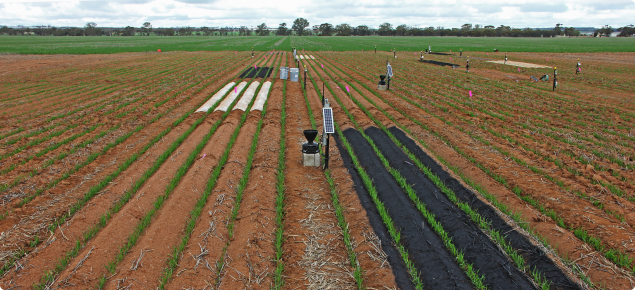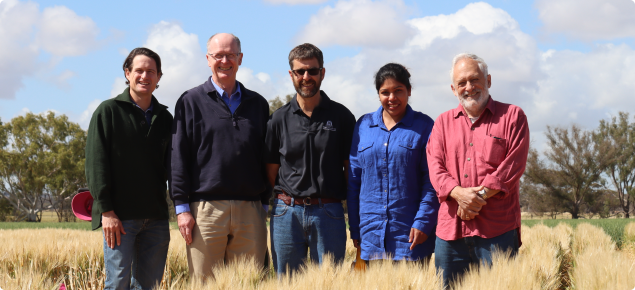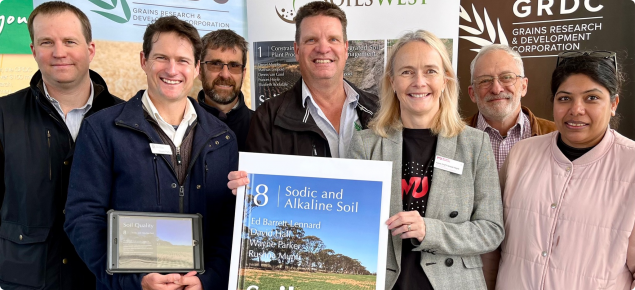Description:
Sodic and alkaline (Calcareous) clay and loam soils are an important soil type in the eastern wheatbelt of Western Australia covering approximately 2 Mha. These soils are often highly productive where soil water is not limiting. However, in most years the unavailability of water severely limits crop production. This is due to a combination of soil physical (aggregate instability, dispersion) and chemical constraints (sodicity, alkalinity, salinity, boron toxicity) that impede water entry, storage and uptake.
Soil management involves both mitigation (live with the problem by managing risk) and amelioration (fixing the problem). Farmer mitigation strategies were investigated in this project (Research Solutions 2021). The focus of this project has been soil amelioration where we have investigated four themes (1) harvesting more water, (2) improving aggregate stability, (3) reducing soil evaporation and (4) stimulating root growth by removing physical impediments. Each theme has elements which are novel.
- Harvesting more water.
Harvesting water from mounded inter-rows that drain into the seeded row has been advocated for regions with unreliable rainfall and sodic soils (Fisher 1995, Fulwood 2014, Mulvany et al., 2018). This novel concept requires water shedding from mounded inter-rows using either natural sealing or waterproof membranes. Results from 16 trial years between 2016 and 2022 have shown that mounding with a waterproof membrane can increase yields by 0.52 t ha-1 representing a 35 % yield increase (Barrett-Lennard et al., 2021). Modelling of the water harvesting system using a combination of APSIM and Hydrus also showed grain yield increases of 0.5 t ha-1 when run with historical (1971 to 2021) rainfall data for Merredin (Thayalakumaran 2022, Appendix A). Most experiments used plastic sheeting as the waterproof membrane as a means to prove the concept. As an alternative to plastic, sprayable polymers were assessed in 2021 and 2022 (Section 9.2.2). The mounds with the sprayable polymer membranes increased yields in both years irrespective of product type. Only one of the three polymers tested was biodegradable. Soil water measurements showed increased water storage within the furrows where plastic and polymer were applied. In the absence of the membranes there was no grain yield increase in 13 of 16 mounded trial years. These findings suggest that cost effective and environmentally friendly membranes need to be developed for adoption of water harvesting in low rainfall environments.
- Improving aggregate stability (Gypsum)
Gypsum (Ca2SO4.2H2O) applied at rates greater than the calculated gypsum requirement reduced dispersion, sodicity, soil pH and salinity levels in unreplicated field investigations. These results are to be expected based on the literature. Gypsum was also applied at commercial rates (2.5 – 3 t ha-1) or low rates in-furrow at seeding (0.05 – 0.1 t ha-1). Based on 32 trial years the average increase in grain yields due to gypsum was 0.13 t ha-1 of which only 5 trial years led to significant (P<0.05) yield increases. None of the gypsum treatments gave a significantly negative grain yield response. There was no difference in average grain yields between broadcast gypsum at high rates and in-furrow gypsum at low rates. Economic analysis of the results suggests that if the small but non significant (P>0.05) yield increases are repeatable then the return on investment to growers would be in the order of 10:1. Our results show that the chemistry of clay dispersion is complex with interactions between ions (cations, anions), pH, mineralogy and salinity affecting dispersion and the likely response to gypsum. In these soils exchangeable sodium percentage (ESP) in the 0 – 30 cm layer was a poor predictor of crop yield (r2 <0.2) compared to pHw (r2 >0.8). Soil response to gypsum, based on turbidimetric analysis which measures suspended clay, shows promise as an alternative to ESP. With further research supporting these current results, this test, or an evolution of, is likely to be the analysis to aid growers with positive return on gypsum investment.
- Reducing soil evaporation
As much as 40 % of rainfall is lost through soil evaporation. Mineral mulches (sand, gravel) reduced cumulative evaporation by 50 - 70 % in glasshouse trials when surface applied to a depth of 2 cm. Field trials (16 trial years) between 2020 and 2023 gave an average grain yield increase of 0.59 t ha-1 with the majority significantly positive (12 trial years). The largest increases in yield occurred in water limited years. The economics of this treatment will depend on longevity of the treatment and initial cost. Anecdotal evidence suggests that the benefits can last for more than 10 years and may also benefit the remediation of salt scalds. The initial cost of spreading was $1200 ha-1 which did not include the mulch. The positive yield results are significant enough to warrant further work in this area to refine techniques/mulch type and lower cost of implementation.
Stimulating root growth through deep tillage
Previous research aimed at amelioration of sodic clay soils has focused on deep ripping with amendments (gypsum, organic matter) to achieve greater rooting depth and sustained yield improvement. This has been a reoccurring theme over the past 40 years but with mixed success and minimal adoption. Part of the reason for this is that many sodic soils have phytotoxic subsoils, that when ripped, are liable to be deposited near the surface resulting in reduced crop yields. Using deep tillage equipment that shattered without delving resulted in no yield increase and of the 11 trial years, four trial years showed significant yield reductions. In our trials (1 site over 5 years) we found no benefit from deep placed gypsum and organic amendments (compost, straw). Further to these results are observations that rooting depth does not extend to the depth of ripping where chemical constraints exist. It is not recommended to deep rip this soil type in a low rainfall zone.
Conclusions
This project has delivered novel systems for managing sodic soils with substantial yield increases. Results have been delivered through ebook (1), scientific publication (1), commissioned reports (3), national/international conferences (2), podcasts (2) industry publications (7), industry presentations (12) and field days (20). The benefit:cost ratio of this project has been assessed at 24:1 (Petersen, 2023). However, the novel nature of this research means that there will be a longer path to market for some of these amelioration techniques.
Funding partner:
GRDC
Project code:
DAW1902-001RTX



